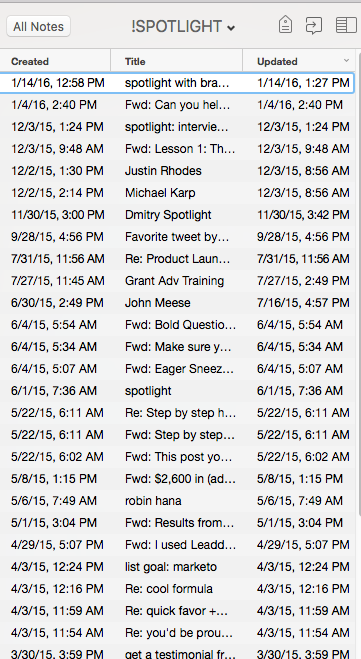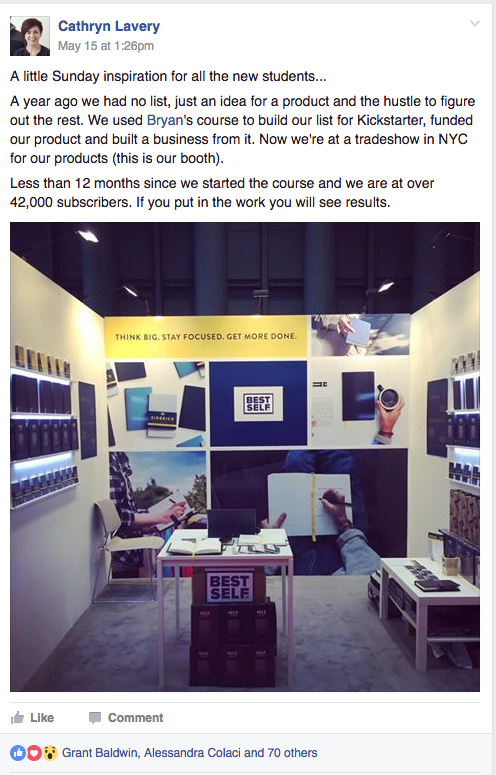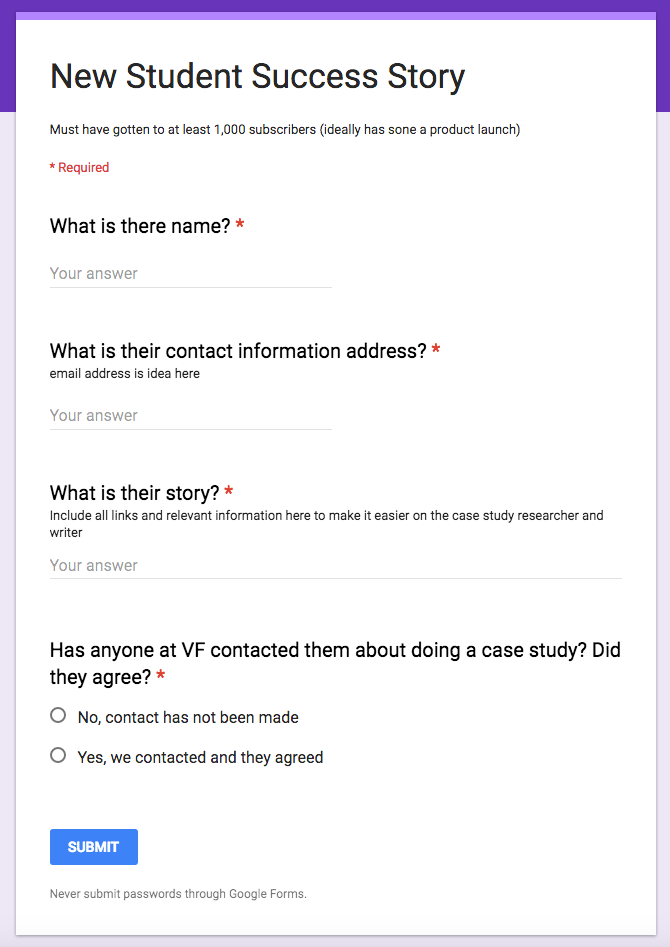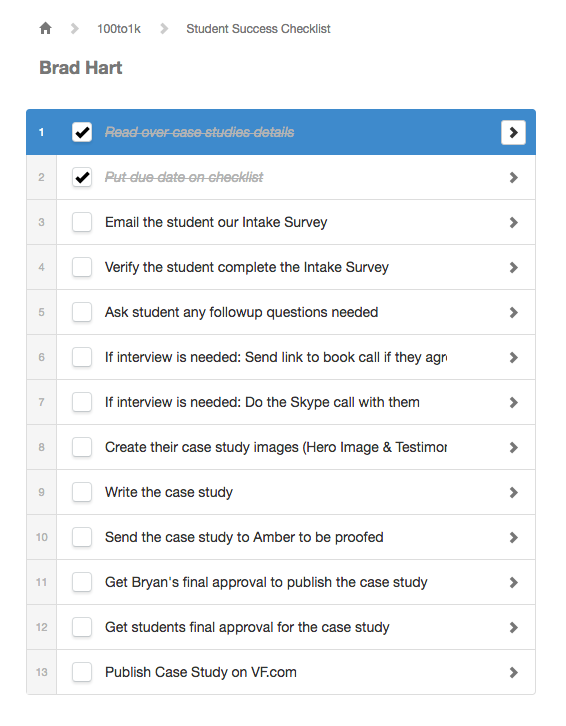Note: This is a slightly more geeky technical post. But I thought it might be fun to experiment with something a little different.
Our #1 goal at VF this year is to help people.
Not in some woo-woo “follow your passion and make a difference in people’s lives” kind of way. But in a super-specific measurable way.
The key thing we’ve identified that will force us to help people is simple.
Publish 100 stories of people who we’ve helped grow their email list to 1,000 subscribers.
The logic: The only way we can publish stories about successful students is to create successful students. And the only way we can create successful students is to legit help them. Not just make a bunch of money by getting 1000s of people into the course, but actually taking the people who come into the course and helping them become successful.
To do that, we have to be able to do some very basic things that our course doesn’t do currently (no course I’ve ever bought does either):
1. Clearly define what success looks like for our students (1,000 subscribers)
2. Track each student’s progress toward that goal
3. Identify when a student gets discouraged and quits
4. Identify when a student stalls in their progress
5. Design systems and programs to help #3 & #4 students get back on track and hit the goal
6. Constantly improve our curriculum to make it more efficient and more likely to get students their results
The theory is that by focusing on legitimately helping people and designing and creating the best curriculum that’s ever been put together on how to build a list and launch a product, growth will take care of itself.
On one level this seems so completely obvious.
“Of course you should track success and optimize for it!”
But look around. Who does this? Who is transparent with this information?
After each course enrollment, we write a post about how great the launch went. But what if we flipped that upside-down, and before each of our course enrollments we INSTEAD published the success numbers from the previous enrollment?
Example…
470 students enrolled
8% never logged in
25% made it past Module 1
4% refunded the course
15% reached 1,000 subs
3% hit 10,000 subs
Note: These aren’t our actual numbers because our tracking isn’t good enough yet.
But that’s what we’re working on in 2016.
We want to know and be able to share with you which strategies, techniques and approaches actually help people.
- Does a Facebook Community make a measurable impact on student success? Or does it hurt it by distracting people?
- What about live Q&A calls in the weeks after a launch? Does that help? If so, what specifically does it help?
- Do re-engagement emails to people who haven’t logged into the course in X days help? Does that re-capture the people who quit or get distracted early and increase their chances of success?
- If you offer a cart extension and get 100 more people to use your product, does that help or hurt their chances of success?
We want to be 100% transparent about the success (or lack thereof) that our students experience with our products.
And that means we have to start optimizing for success.
One of the workflows that we’ve had to develop as a result of our #1 goal (100 people to 1k subs) is identifying and writing these stories.
This sounds fairly straightforward, but our processes for this were nearly nonexistent a few months ago.It mostly consisted of an Evernote notebook where we randomly stuck emails or screenshots any time someone sounded like they had some success with the course.

Now we have a fine-tuned workflow that identifies successful students, captures their stories and produces great written case studies that we can use to help more people make the decision to enroll into 10ksubs and start their journeys.
Today I want to show you how it works so you can do the same thing.
Our process for capturing, writing and publishing case studies
Step 1: Find successful students.
Note: I’ll be using the word “student” throughout this piece because our primary product is a course. But feel free to adapt for your context (user, customer etc.).
The first step is to identify students who have hit our success mark: 1,000 subscribers.
Currently we do that three ways:
Way #1: We look daily in the community for people who have posted their progress.

Way #2: We pay attention to every support ticket or inbound email for people who have reported their progress.
Way #3: We use ListGoal.com to track people’s progress.
Step 2: Enter their info into a Google form.
The moment anyone on the team identifies a success story, they enter that person’s information into a simple Google form.

When submitted, that Google form auto-generates a checklist that is assigned to Jeremy (the dean of 10ksubs).
Step 3: Do what the checklist says.
The last step is for Jeremy to create the case study by following the checklist we’ve put together.

A few final notes
We use a program called Process.st to manage all of our recurring and trigger-based checklists. It integrates with Zapier and allows you to automate checklists to be triggered and assigned based on nearly any action you can think of.
Pretty powerful combination.
Here are a few of the stories we’ve published so far:
Story #1: Justin grew his email list from 0 to 1,821 subscribers and produced a documentary on chicken farming
Story #3: John grew his email list from 0 to 250 subscribers and quit his full time job at Chik-fil-a
..
PS: Do you have a cool workflow for capturing stories of successful students? Let me know in the comments below. Or, if you have any questions on our progress, ask those below.